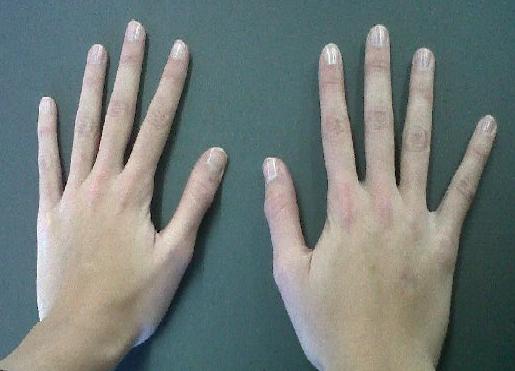WBR0654
| Author | PageAuthor::Neeraja Danda M.B.B.S |
|---|---|
| Exam Type | ExamType::USMLE Step 2 CK |
| Main Category | MainCategory::Internal medicine |
| Sub Category | SubCategory::Cardiovascular |
| Prompt | [[Prompt::An 18 year old male patient presents to his primary care physician complaining of increased fatigue for the past several days.Physical examination is significant for unusually long arms with fingers as shown in the figure below and flat feet.
 Image courtesy: BQmUB2010144 ¬ Own work 12:20 13 december 2010, http://en.wikipedia.org/wiki/File:Aracnodactilia.jpg Examination of the spine shows scoliosis. Upper limb joints are hypermobile. Cardiac auscultation is significant for a diastolic murmur at the lower left sternal border. Echocardiography shows valve regurgitation in the heart .Which of the following is not a characteristic feature of patient’s cardiac condition?]] |
| Answer A | AnswerA::Diastolic decrescendo murmur |
| Answer A Explanation | AnswerAExp::'''Incorrect''' Diastolic decrescendo murmur at the lower left sternal border is heard in aortic regurgitation. |
| Answer B | AnswerB::Capillary pulsations in the finger nails. |
| Answer B Explanation | AnswerBExp::'''Incorrect''' Capillary pulsations in the finger nails (quinke pulse) is seen in aortic regurgitation |
| Answer C | AnswerC::Femoral artery murmur |
| Answer C Explanation | AnswerCExp::'''Incorrect''' In aortic regurgitation, a murmur can heard over the femoral artery (duroziez’s sign) |
| Answer D | AnswerD::Head bobbing with each pulse |
| Answer D Explanation | AnswerDExp::'''Incorrect''' Musset’s sign refers to head bobbing with each pulse. This sign is also seen in aortic regurgitation. |
| Answer E | AnswerE::Vocal hoarseness |
| Answer E Explanation | AnswerEExp::Vocal hoarseness is a feature of mitral stenosis where an enlarged left atrium presses on recurrent laryngeal nerve. |
| Right Answer | RightAnswer::E |
| Explanation | [[Explanation::Arachnodactyly (spider fingers) are long slender fingers as shown in the image, a feature of some connective tissue diseases Marfans syndrome being one of them. Unusually lengthy arms, flat feet and scoliosis are also associated with Marfans syndrome. In this patient echocardiography showed a valve regurgitation and a diastolic murmur could be heard at the lower left sterna border, that suggests aortic regurgitation. Marfans syndrome is one of the causes of aortic regurgitation along with reactive arthritis, ankylosing spondylitis and syphilis. This patient most likely has aortic regurgitation secondary to marfans syndrome. All the features given in the options are features of aortic regurgitation except hoarseness of the voice which is seen in mitral stenosis due to compression of the recurrent laryngeal nerve.
Educational Objective: Hoarseness of the voice is not seen in aortic regurgitation. It is a feature of mitral stenosis where an enlarged left atrium presses on recurrent laryngeal nerve to produce a hoarse voice. References:Page 91 Master the boards step 2 CK second edition, Page 64 Master the boards step 3 2009 edition, http://www.wikidoc.org/index.php/Marfan%27s_syndrome_pathophysiology William James Gibson, C. Michael Gibson, M.S., M.D. 14:38, 22 August 012, http://www.wikidoc.org/index.php/Arachnodactyly |
| Approved | Approved::Yes |
| Keyword | WBRKeyword::Aortic regurgitation, WBRKeyword::Duroziez's sign, WBRKeyword::Musset's sign |
| Linked Question | Linked:: |
| Order in Linked Questions | LinkedOrder:: |